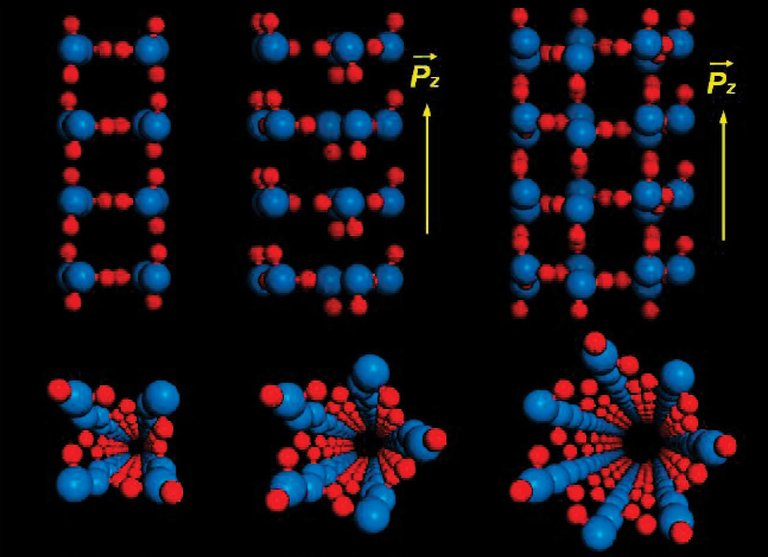
The structure of the quadrangular, pentagonal and heptagonal nano ice inside single-walled nanotube. Blue and red balls correspond to atoms of oxygen and hydrogen.
The unusual properties of water have long been the subject of intense study scientists. Ten years ago, it became clear that inside the nanotubes with a diameter of less than 2.5 nm, the water does not freeze and continues to flow even at temperatures close to absolute zero (-273,15 ° C). Oddities do not end there.
Phase transitions of water with the change of the state of aggregation of carbon nanotubes inside is clearly not fit into the standard theory of thermodynamics. This applies not only to the freezing point and boiling point. As is known, at normal atmospheric pressure boiling point of water is about 100 ° C. With increasing pressure in the tank increases the boiling point - this principle using a pressure cooker to cook food faster. Conversely, the boiling point of water can be reduced by reducing the pressure. For example, in the mountains at an altitude of 5 km to cook some food in principle impossible, because there is the boiling point of water is only 83 ° C due to the low atmospheric pressure.
Scientists also know that the phase transition temperature of the water also depends on the shape and size of the vessel. When the pressure vessel using an invariance can slide volume boiling point or freezing point of about 10 ° C. But carbon nanotubes things get turned upside down. As already mentioned, there is the water retains the liquid state at temperatures close to absolute zero. Now scientists from the Massachusetts Institute of Technology (MIT) have investigated in detail another interesting phenomenon - a phase transition in the solid state (ice nanotubes) at high temperature, when under normal conditions, water must evaporate.
This phenomenon discovered in 2001 by a group of Japanese and American scientists. Ice nanotubes are of particular interest because they are formed at a high temperature and can be used in various electronic nanodevices, including gas nanoturbinah, nanosensors flow and high flux membranes. Moreover, the ability to freeze water into ice nanotubes at temperatures much below 0 ° C allows the use of ice in the heat exchange systems nanotubes. Experimental Confirmation of such use have been received but has not yet been known and studied the exact dimensions and parameters of carbon nanotubes, which are necessary for the hardening of water at room temperature and above.
So far, most of the experiments with the phase transition of water in carbon nanotubes were limited to molecular dynamics simulations on the computer rather than the actual physical experiences. As a result, the simulation revealed that the water properties are highly dependent on the diameter of the carbon nanotube. For example, the pore diameter of 0.8-1.0 nm in water stabilized well in the vapor state, and somewhere between the tube diameters of 1.1 and 1.2 nm simulations show stabilization in the form of ice, that is in a solid form. Then, by increasing the diameter over 1.4 nm stabilization occurs again in liquid form. All this is very interesting - and therefore at MIT have developed a methodology for physical experiments to test the properties of water in carbon nanotubes with a diameter from 1.05 to 1.52 nm with single and double-skinned. The authors of the experiment also developed a water monitoring equipment in nanotubes using Raman spectroscopy (radial oscillations, RBM).

Experimental set-up for growing nanotubes and filling with water (hydrophobic why nanotubes passed into the water - scientists also do not fully understand); Computer models of single-layer and dual-layer nanotubes for the experiment; results of Raman spectroscopy
Experiments have shown that in certain diameter nanotube water enters the solid state of aggregation at temperatures above 100 ° C. Maximum recorded phase transition temperature is from 105 ° C to 151 ° C (more precisely measured failed) single-walled nanotube with a diameter of 1.05 nm. This is much higher than the parameters that predicted by theory. In some cases, the actual freezing point was almost 100 ° C higher than predicted by theory. The first experiments were conducted in a real laboratory conditions - as it turned out, not in vain. Nobody expected such a big difference in the properties of water in nanotubes with a diameter of 1.05 and 1.06 nm.

The blue color on the chart - the solid state of water, green - liquid state, red - empty nanotubes (dry state)
After passing through the freezing point, scientists have lowered the temperature of the water and returned to the liquid state, demonstrating the reversibility of the process. The nanotube diameter of 1.06 nm, the ice melted at a temperature of 87-117 ° C, in nanotubes 1.44 and 1.52 nm, the freezing point is between 15-49 ° C and 3-30 ° C respectively.
Nanolёd has an interesting combination of electrical and thermal properties. The presence of ice which does not melt at a temperature of up to + 151 ° C, may be of interest to engineers and designers. At room temperature, this ice is absolutely stable, it is quite possible to use the wires in the electronics and other devices (water - one of the best proton conductors known to science) which do not heat up to + 151 ° C, otherwise the wire will melt.
Scientific work published November 28, 2016 in the journal Nature Nanotechnology (doi: 10.1038 / nnano.2016.254).
Referenced Materials:
- http://pubs.acs.org/doi/abs/10.1021/nl072642r
- https://www.sciencedaily.com/releases/2005/06/050605183843.htm
- http://www.nature.com/nnano/journal/vaop/ncurrent/full/nnano.2016.254.html
- http://www.nature.com/nature/journal/v412/n6849/abs/412802a0.html
- http://www.nature.com/nmat/journal/v6/n2/abs/nmat1823.html
- http://www.sciencedirect.com/science/article/pii/S1359431102000352
- http://news.mit.edu/2016/carbon-nanotubes-water-solid-boiling-1128
This post has been ranked within the top 80 most undervalued posts in the second half of Dec 05. We estimate that this post is undervalued by $6.21 as compared to a scenario in which every voter had an equal say.
See the full rankings and details in The Daily Tribune: Dec 05 - Part II. You can also read about some of our methodology, data analysis and technical details in our initial post.
If you are the author and would prefer not to receive these comments, simply reply "Stop" to this comment.